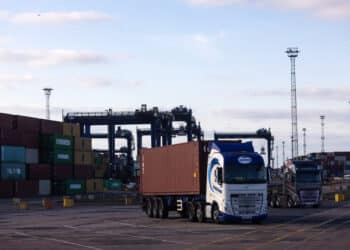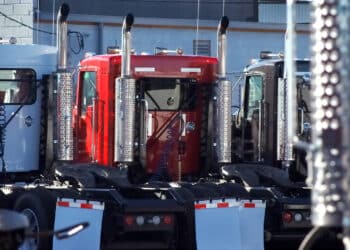Daimler Truck’s new CEO unveils strategy
Daimler Truck financial services originations fell 10% YoY
German commercial vehicle manufacturer Daimler Truck unveiled new strategic tenets under its new chief executive during the company’s third quarter earnings call today.
Karin Radstrom, who became chief executive on Sept. 5, began the call by outlining her four priorities for the company: shaping the industry on its path to sustainability, becoming a better partner for its customers, developing engaged and motivated employees, and improving profitability to benchmark levels through robust and resilient operations.
While Daimler Truck expects several changes over the next 100 days, it is in a good position to seize market opportunities, Radstrom said.
“We are in a strong position in all our key markets as we are No. 1 or No. 2 in more or less all of them, and we have fantastic dealers and great customer relations,” she said. “There are a lot of restraints to build on, but I think we can also leverage synergies even more, and we can use our global portfolio even better.”
Daimler expects to collaborate with the administration of President-elect Donald Trump and the Environmental Protection Agency (EPA) as it did under the previous administration, Radstrom said.
“I’m convinced that it will work very well,” she said. “On the EPA, I don’t expect any changes in that legislation, as it’s been consistent over many years, so I think that was the key.”

Daimler Truck by the numbers
Daimler Truck Group’s performance declined in Q3, despite Daimler Truck North America’s (DTNA) positive quarter:
- Group revenue declined 5% year over year to 13.1 billion euros ($14.2 billion);
- Financial services revenue rose 21% YoY to $897.4 million;
- Originations, or new business volume, dropped 10.3% to $3 billion;
- Total outstandings, or contract volume, rose 5.8% YoY to $32.3 billion;
- DTNA units sold increased 4.1% YoY to 49,176 units;
- DTNA incoming orders rose 4.4% YoY to 36,837 units;
- DTNA production grew 3.7 % to 48,527 units;
- Group truck units sold fell 10.8% YoY to 114,917 units;
- Group incoming orders declined 4.4% YoY to 94,709 units;
- Group production dropped 9.3% to 115,920 units;
- Daimler Truck’s global zero-emission vehicles (ZEV) sales rose to 666 units, up 35.6% YoY; and
- Daimler Truck’s global ZEV orders slipped to 1,040 units, down 4.1% YoY
Market outlook
Despite the positive performance on zero-emissions vehicles, infrastructure concerns persist, Radstrom said.
“The right products are available, and they do get great customer feedback, so it is therefore becoming more and more obvious that there is one serious challenge on the road towards sustainable transportation, and that’s infrastructure,” she said. “Today, there are only 600 public charging stations for battery power trucks in Europe, and by 2030, 35,000 such charging stations will be needed, and this is not some artificial figure. It’s derived from the [carbon dioxide] targets set for our industry.”
To meet infrastructure demands in Europe and the United States, Daimler launched pilot infrastructure projects, Radstrom said. In the United States, Daimler Truck North America partnered with NextEra Energy Resources and BlackRock Alternatives to form a joint venture called Greenlane, which is developing a charging corridor from Los Angeles to Los Vegas, according to an April 3 Daimler Truck release.
While Daimler Truck’s overall performance underperformed, the group remains confident in Daimler Truck North America moving forward, Radstrom said.
“First, overall demand in North America remains solid, and second, our vocational track strategy is paying off,” she said. “Vocational trucks help offset the decline in on-highway volume, so we have reduced our dependency on the on-highway market, and therefore increased our resilience.”
Shares of Daimler Truck Holding AG [OTCMKTS:DTGHF] were trading at $41.52 at market close today, up 4.6% or $1.84 from market open. Daimler has a market capitalization of $32.26 billion.
Editor’s note: All amounts have been converted to U.S. dollars.









